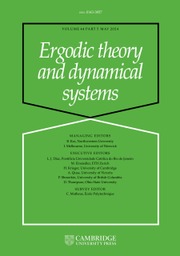No CrossRef data available.
Article contents
On quasiconformal non-equivalence of gasket Julia sets and limit sets
Published online by Cambridge University Press: 09 June 2025
Abstract
This paper studies quasiconformal non-equivalence of Julia sets and limit sets. We proved that any Julia set is quasiconformally different from the Apollonian gasket. We also proved that any Julia set of a quadratic rational map is quasiconformally different from the gasket limit set of a geometrically finite Kleinian group.
MSC classification
Secondary:
30C62: Quasiconformal mappings in the plane
Information
- Type
- Original Article
- Information
- Copyright
- © The Author(s), 2025. Published by Cambridge University Press
References
Bourgain, J. and Fuchs, E.. A proof of the positive density conjecture for integer Apollonian circle packings. J. Amer. Math. Soc. 24(4) (2011), 945–967.CrossRefGoogle Scholar
Bourgain, J. and Kontorovich, A.. On the local-global conjecture for integral Apollonian gaskets. Invent. Math. 196(3) (2014), 589–650.CrossRefGoogle Scholar
Bogachev, N., Kolpakov, A. and Kontorovich, A.. Kleinian sphere packings, reflection groups, and arithmeticity. Math. Comp. 93 (2024), 505–521.CrossRefGoogle Scholar
Bonk, M., Kleiner, B. and Merenkov, S.. Rigidity of Schottky set. Amer. J. Math. 131(2) (2009), 409–443.CrossRefGoogle Scholar
Bonk, M., Lyubich, M. and Merenkov, S.. Quasisymmetries of Sierpiśki carpet Julia sets. Adv. Math. 301 (2016), 383–422.CrossRefGoogle Scholar
Bonk, M. and Merenkov, S.. Quasisymmetric rigidity of square Sierpinśki carpets. Ann. of Math. (2) 177 (2013), 591–643.CrossRefGoogle Scholar
Cui, G. and Tan, L.. Hyperbolic-parabolic deformations of rational maps. Sci. China Math. 61 (2018), 2157–2220.CrossRefGoogle Scholar
Douady, A. and Hubbard, J.. A proof of Thurston’s topological characterization of rational functions. Acta Math. 171 (1993), 263–297.CrossRefGoogle Scholar
Graham, R., Lagarias, J., Mallows, C., Wilks, A. and Yan, C.. Apollonian circle packings: number theory. J. Number Theory 100 (2003), 1–45.CrossRefGoogle Scholar
Graham, R., Lagarias, J., Mallows, C., Wilks, A. and Yan, C.. Apollonian circle packings: geometry and group theory I. The Apollonian group. Discrete Comput. Geom. 34 (2005), 547–585.CrossRefGoogle Scholar
Haïssinsky, P. and Tan, L.. Convergence of pinching deformations and matings of geometrically finite polynomials. Fund. Math. 181 (2004), 143–188.CrossRefGoogle Scholar
Kapovich, M. and Kontorovich, A.. On superintegral Kleinian sphere packings, gugs, and arithmetic groups. J. Reine Angew. Math. 798 (2023), 105–142.Google Scholar
Kontorovich, A. and Nakamura, K.. Geometry and arithmetic of crystallographic sphere packings. Proc. Natl. Acad. Sci. USA 116(2) (2019), 436–441.CrossRefGoogle ScholarPubMed
Kontorovich, A. and Oh, H.. Apollonian circle packings and closed horospheres on hyperbolic 3-manifolds. J. Amer. Math. Soc. 24 (2011), 603–648.CrossRefGoogle Scholar
Lodge, R., Luo, Y. and Mukherjee, S.. Circle packings, kissing reflection groups and critically fixed anti-rational maps. Forum Math. Sigma 10 (2022), Paper no. e3.CrossRefGoogle Scholar
Lodge, R., Luo, Y. and Mukherjee, S.. On deformation space analogies between Kleinian reflection groups and antiholomorphic rational maps. Geom. Funct. Anal. 32 (2022), 1428–1485.CrossRefGoogle Scholar
Lodge, R., Lyubich, M., Merenkov, S. and Mukherjee, S.. On dynamical gaskets generated by rational maps, Kleinian groups, and Schwarz reflections. Conform. Geom. Dyn. 27(1) (2023), 1–54.CrossRefGoogle Scholar
Luo, J..
Combinatorics and holomorphic dynamics: captures, matings and Newton’s method
. PhD Thesis, Cornell University, 1995.Google Scholar
Luo, Y. and Zhang, Y.. Circle packings, renormalizations and subdivision rules. Preprint, 2023, arXiv:2308.13151.Google Scholar
Maskit, B.. Intersections of component subgroups of Kleinian groups. Discontinuous Groups and Riemann Surfaces: Proceedings of the 1973 Conference at the University of Maryland (Annals of Mathematical Statistics, 79). Ed. Greenberg, L.. Princeton University Press, Princeton, NJ, 1974, pp. 349–367.CrossRefGoogle Scholar
McMullen, C.. Iteration on Teichmüller space. Invent. Math. 99 (1990), 425–454.CrossRefGoogle Scholar
Merenkov, S.. Local rigidity for hyperbolic groups with Sierpiński carpet boundaries. Compos. Math. 150(11) (2014), 1928–1938.CrossRefGoogle Scholar
Milnor, J.. Geometry and dynamics of quadratic rational maps, with an appendix by the author and Lei Tan. Exp. Math. 2(1) (1993), 37–83.CrossRefGoogle Scholar
Milnor, J.. Dynamics in One Complex Variable (Annals of Mathematics Studies, 160). Princeton University Press, Princeton, NJ, 2006.Google Scholar
Oh, H. and Shah, N.. The asymptotic distribution of circles in the orbits of Kleinian groups. Invent. Math. 187 (2012), 1–35.CrossRefGoogle Scholar
Pilgrim, K. and Tan, L.. Combining rational maps and controlling obstructions. Ergod. Th. & Dynam. Sys. 18 (1998), 221–245.CrossRefGoogle Scholar
Qiu, W., Yang, F. and Zeng, J.. Quasisymmetric geometry of Sierpiński carpet Julia sets. Fund. Math. 244 (2019), 73–107.CrossRefGoogle Scholar
Sullivan, D.. On the ergodic theory at infinity of an arbitrary discrete group of hyperbolic motions. Riemann Surfaces and Related Topics: Proceedings of the 1978 Stony Brook Conference (Annals of Mathematical Statistics, 97). Ed. Kra, I. and Maskit, B.. Princeton University Press, Princeton, NJ, 1981, pp. 465–496.CrossRefGoogle Scholar
Tan, L.. Matings of quadratic polynomials. Ergod. Th. & Dynam. Sys. 12 (1992), 589–620.Google Scholar
Thurston, W.. Hyperbolic structures on 3-manifolds I: deformation of acylindrical manifolds. Ann. of Math. (2) 124 (1986), 203–246.CrossRefGoogle Scholar
Wittner, B..
On the bifurcation loci of rational maps of degree two
. PhD Thesis, Cornell University, 1988.Google Scholar
Zhang, Y.. Elementary planes in the Apollonian orbifold. Trans. Amer. Math. Soc. 376(1) (2023), 453–506.Google Scholar


